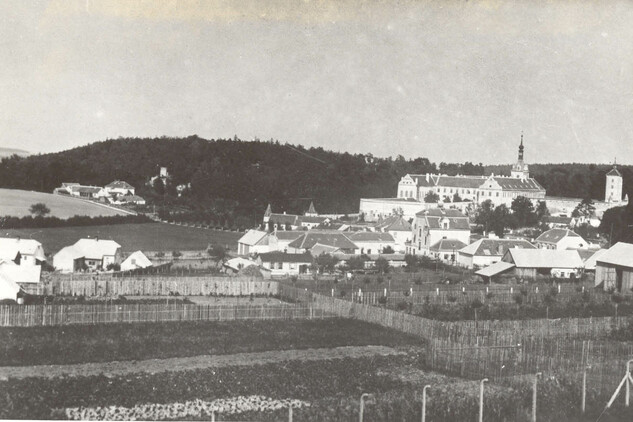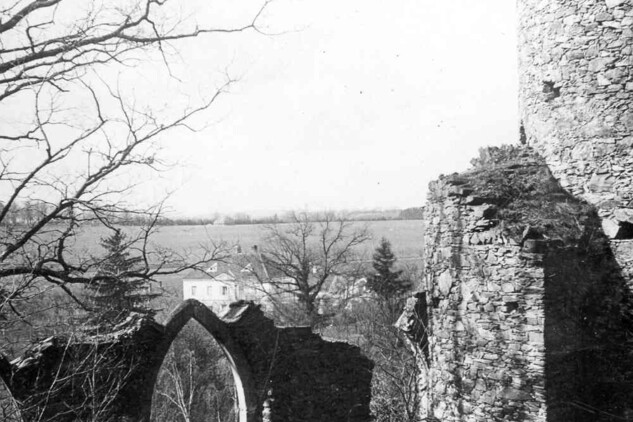Umělá zřícenina
Nejvyhledávanější stavbou zámeckého parku v Uherčicích je umělá zřícenina hrádku, která se tyčí nad takzvanou Klampferskou loukou. Zřícenina, vystavěná patrně roku 1803 podle plánů architekta Antona Ortnera, má podobu středověké válcové věže s gotickým portálem. Od začátku sloužila jako vyhlídka, z níž si bylo možné prohlížet zámek, jeho okolí a většinu romantických staveb v parku. Móda umělých zřícenin přišla do střední Evropy z Anglie, kde měli romantičtí čtenáři v oblibě strašidelné takzvané gotické romány. Na umělé ruiny bylo možné v závěru 18. století narazit v anglických parcích v Německu a o něco později také v celé habsburské monarchii. Tou nejslavnější umělou zříceninou u nás je známý Janův hrad nedaleko Lednice, vybudovaný knížaty z Liechtensteinu. Kromě této vyhlídky navrhl architekt Anton Ortner v Uherčicích i další, dnes už zaniklé romantické stavby – gloriet, Dianin chrám, stojící na nedalekém návrší, poustevnu či altán, přenesený roku 1810 do parku z francouzské zahrady. Procházku anglickým parkem ozvláštňovalo i několik dalších prvků, například terasa, vybudovaná kolem vzrostlého dubu, nebo několik mostků, postavených přes potok Blatnici, který park lemuje.
The most frequently visited building in the château grounds at Uherčice is the artificial ruined castle towering above the so-called Klampfer meadow. The ruins, probably built in 1803 according to plans drafted by Anton Ortner, imitate a mediaeval cylindrical tower with a Gothic portal. They were intended as a lookout post, allowing a good view of the château, its surroundings, and most of the romantic follies on the grounds. The vogue for artificial ruins came to Central Europe from England, where romantic readers had a particular fondness for Gothic novels. Towards the close of the eighteenth century, visitors could encounter artificial ruins in English parks in Germany, and slightly later also all over the Habsburg Empire. The most famous artificial ruin in the Czech Republic is Janův hrad (John’s Castle) near Lednice Château, built by the Liechtenstein princes. In addition to the lookout, Anton Ortner also designed other, no longer extant romantic follies for Uherčice – a gloriette, a temple of the goddess Diana, located on a none-too-distant hillock, a hermitage, and a gazebo, which was moved to the park from the French garden in 1810. Other features built to delight visitors strolling through the grounds included a terrace constructed around a stately oak tree and several footbridges over the Blatnice, a stream that skirts the park.
Der am meisten besuchte Bau des Schlossparks in Uherčice ist die künstliche Burgruine, die über der sogenannten Klamfer-Wiese thront. Die vermutlich 1803 nach Plänen des Architekten Anton Ortner erbaute Ruine hat die Form eines mittelalterlichen Rundturms mit gotischem Portal. Von Anfang an diente er als Aussichtspunkt, von dem man sich das Schloss, seine Umgebung und die meisten romantischen Gebäude des Parks ansehen konnte. Die Mode der künstlichen Ruinen kam aus England nach Mitteleuropa, wo romantische Leser eine Vorliebe für die gespenstischen sog. gotischen Roman hatten. Künstliche Ruinen fand man in englischen Parks in Deutschland im 18. Jahrhundert und etwas später auch in der Habsburgermonarchie. Die bekannteste künstliche Ruine unseres Landes ist die berühmte Hansenburg bei Lednice, erbaut von den Fürsten von Liechtenstein. Neben dieser Aussicht entwarf der Architekt Anton Ortner in Uherčice auch andere, heute nicht mehr existierende romantische Gebäude – die Gloriette, den Dianatempel , der auf einem nahe gelegenen Hügel steht, die Einsiedelei oder den Altan, der im Jahre 1810 aus dem französischen Garten in den Park übertragen wurde. Ein Spaziergang durch den englischen Park wurde auch durch einige andere Elemente interessant, wie z. B. eine Terrasse, die um eine alte Eiche herum gebaut wurde oder mehrere Brücken, die über den Blatnice-Bach, der den Park umgrenzt, gebaut wurden.



